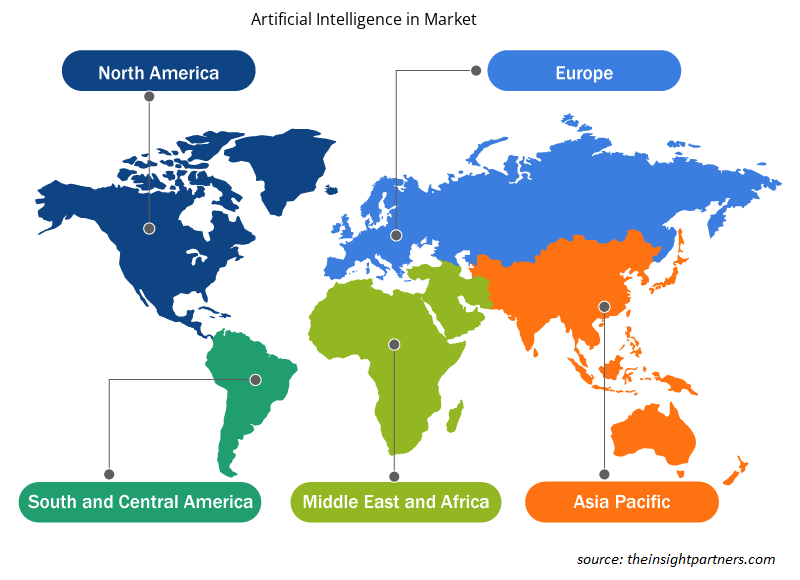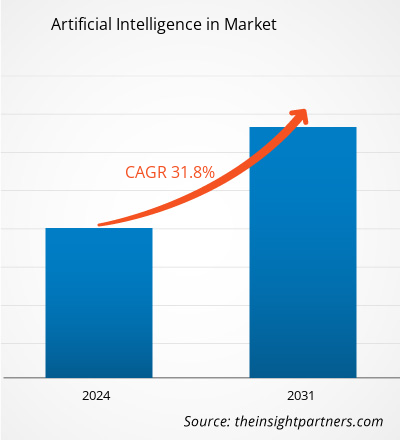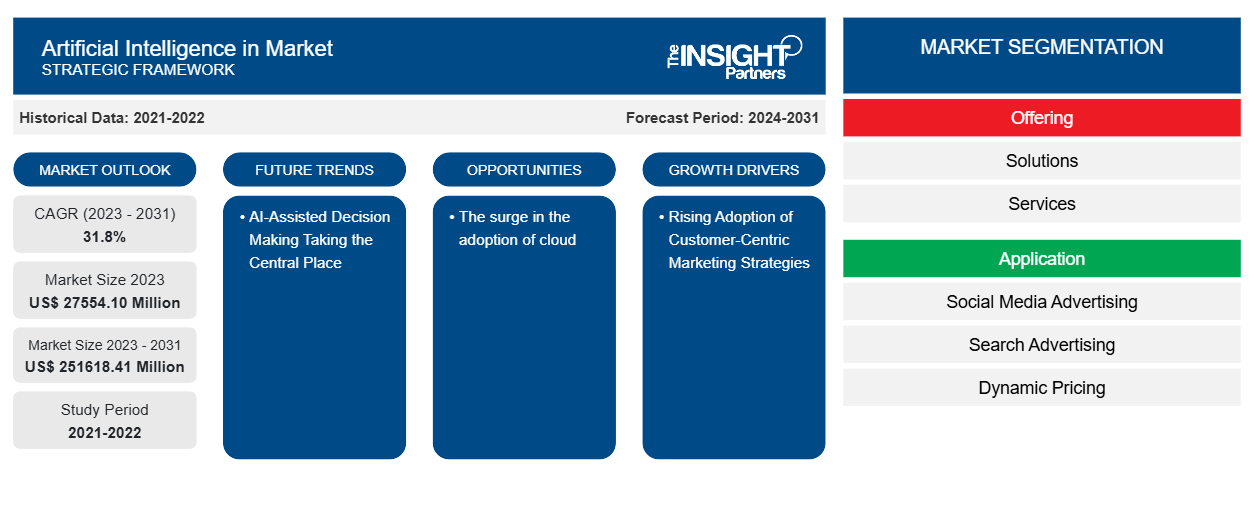Se proyecta que el tamaño del mercado de inteligencia artificial en marketing alcance los 251 618,41 millones de dólares en 2031, frente a los 27 554,10 millones de dólares en 2023. Se espera que el mercado registre una CAGR del 31,8 % durante el período 2023-2031. Es probable que la toma de decisiones asistida por IA siga siendo una tendencia clave en el mercado.
Inteligencia artificial en el marketing Análisis de mercado
El uso cada vez mayor de las plataformas de redes sociales para la publicidad y la creciente adopción de estrategias de marketing centradas en el cliente son algunos de los factores que impulsan el crecimiento del mercado de la inteligencia artificial en el marketing. Sin embargo, la escasez de personal con conocimientos especializados en IA obstaculiza el crecimiento del mercado. Además, el aumento en la adopción de aplicaciones y servicios basados en la nube crea oportunidades notables para los actores del mercado de la inteligencia artificial en el marketing.
Visión general del mercado de inteligencia artificial en marketing
Las tecnologías de inteligencia artificial (IA) se utilizan en marketing para ayudar a la toma de decisiones automatizada basada en la recopilación de datos, el análisis y las observaciones adicionales de la audiencia o de las tendencias económicas que podrían afectar a las campañas de marketing. La IA se utiliza con frecuencia en las campañas de marketing digital cuando la eficiencia es crucial. Cuando la velocidad es crucial en las iniciativas de marketing digital, se utiliza con frecuencia la IA generativa . Las soluciones de marketing de IA aprenden a interactuar con los clientes de la manera más eficaz mediante el uso de datos y perfiles de clientes. Luego, envían mensajes personalizados en el momento adecuado sin la ayuda de las personas del equipo de marketing, lo que garantiza una productividad óptima. Una gran cantidad de especialistas en marketing digital modernos utilizan la IA generativa para respaldar a sus equipos o realizar actividades más tácticas que requieren menos delicadeza humana.
Personalice este informe según sus necesidades
Obtendrá personalización en cualquier informe, sin cargo, incluidas partes de este informe o análisis a nivel de país, paquete de datos de Excel, así como también grandes ofertas y descuentos para empresas emergentes y universidades.
-
Obtenga las principales tendencias clave del mercado de este informe.Esta muestra GRATUITA incluirá análisis de datos, desde tendencias del mercado hasta estimaciones y pronósticos.
Inteligencia artificial en marketing: impulsores y oportunidades del mercado
Creciente adopción de estrategias de marketing centradas en el cliente
Para prosperar en el mercado global ferozmente competitivo, muchas empresas, independientemente del sector al que pertenezcan, se están centrando en construir relaciones a largo plazo y mutuamente beneficiosas con sus clientes. El enfoque de las tácticas y acciones de interacción con el cliente ha cambiado en los últimos años, pasando de estar principalmente orientadas al producto a estar más centradas en el cliente. Al adoptar un enfoque centrado en el cliente, las empresas pueden anticipar y atender mejor las necesidades de sus clientes en todo momento. Se ha demostrado que las empresas que han realizado una transición eficaz a la interacción centrada en el cliente tienen una ventaja competitiva significativa, así como un aumento de las ventas y los ingresos. Según Harvard Business Review, más de un tercio de las organizaciones de Fortune 500 se han reestructurado teniendo al cliente en mente, empleando los recorridos, las preferencias y la segmentación como principios impulsores. Sin embargo, muchas empresas conocidas han adoptado eficazmente la orientación al cliente en los últimos años. Entre las empresas centradas en el cliente más populares en los EE. UU. se incluyen USAA, Tumi y American Express. Las aerolíneas como Singapore Airlines, Air Innovative Zealand y Emirates están abandonando sus métodos tradicionales en favor de formas publicitarias innovadoras.
El aumento en la adopción de la nube
Para los usuarios de la nube, la inteligencia artificial (IA) se ha convertido en una herramienta multifuncional para la gestión de datos, la seguridad, el análisis de datos y la toma de decisiones estratégicas. Su capacidad para utilizar el aprendizaje automático y producir interpretaciones objetivas de información basada en datos aumenta la eficiencia de estos procedimientos y permite a las empresas ahorrar una cantidad sustancial de dinero. El uso de software de IA basado en algoritmos de aprendizaje automático en entornos de nube permite a las empresas ofrecer a los usuarios y consumidores experiencias conectadas y fáciles de usar. Por lo tanto, el aumento en la adopción de la nube está creando varias oportunidades para el mercado.
Análisis de segmentación del informe de mercado de inteligencia artificial en marketing
Los segmentos clave que contribuyeron a la derivación de la inteligencia artificial en el análisis del mercado de marketing son la industria de oferta, aplicación y uso final.
- Según la oferta, el mercado de inteligencia artificial en marketing se divide en soluciones y servicios. El segmento de soluciones tuvo una mayor participación de mercado en 2023.
- Por aplicación, el mercado se segmenta en publicidad en redes sociales, publicidad en buscadores, precios dinámicos, asistente virtual, curación de contenido, automatización de ventas y marketing, plataforma de análisis y otros. El segmento de publicidad en redes sociales tuvo una mayor participación de mercado en 2023.
Por industria de uso final, el mercado está segmentado en BFSI, venta minorista, bienes de consumo, medios y entretenimiento, y otros.
Análisis de la cuota de mercado de la inteligencia artificial en marketing por geografía
El alcance geográfico del informe de mercado de inteligencia artificial en marketing se divide principalmente en cinco regiones: América del Norte, Asia Pacífico, Europa, Medio Oriente y África, y América del Sur y Central.
América del Norte domina el mercado de la inteligencia artificial en el marketing. Los actores clave del mercado de la inteligencia artificial en el marketing, como Adobe, Amazon Web Services, IBM, Salesforce y Accenture, han estado adoptando diversas estrategias orgánicas e inorgánicas para mejorar sus ingresos y posiciones en el mercado. Por ejemplo, Appier lanzó ARTIFICIAL INTELLIGENCEXPERT, un asistente publicitario basado en aplicaciones impulsado por INTELIGENCIA ARTIFICIAL que ayuda a los especialistas en marketing a escalar fácilmente el rendimiento de sus campañas de ventas a través de campañas de inteligencia artificial en enero de 2021. Por lo tanto, el mercado está creciendo en la región.
Alcance del informe de mercado de inteligencia artificial en marketing
Inteligencia artificial en el mercado: perspectivas regionales
Los analistas de Insight Partners explicaron en detalle las tendencias y los factores regionales que influyen en la inteligencia artificial en el mercado durante el período de pronóstico. Esta sección también analiza los segmentos y la geografía de la inteligencia artificial en el mercado en América del Norte, Europa, Asia Pacífico, Oriente Medio y África, y América del Sur y Central.

- Obtenga datos regionales específicos sobre inteligencia artificial en el mercado
Alcance del informe sobre inteligencia artificial en el mercado
| Atributo del informe | Detalles |
|---|---|
| Tamaño del mercado en 2023 | US$ 27554,10 millones |
| Tamaño del mercado en 2031 | US$ 251.618,41 millones |
| CAGR global (2023 - 2031) | 31,8% |
| Datos históricos | 2021-2022 |
| Período de pronóstico | 2024-2031 |
| Segmentos cubiertos |
Al ofrecer
|
| Regiones y países cubiertos |
América del norte
|
| Líderes del mercado y perfiles de empresas clave |
|
Inteligencia artificial en la densidad de actores del mercado: comprender su impacto en la dinámica empresarial
El mercado de la inteligencia artificial está creciendo rápidamente, impulsado por la creciente demanda de los usuarios finales debido a factores como la evolución de las preferencias de los consumidores, los avances tecnológicos y una mayor conciencia de los beneficios del producto. A medida que aumenta la demanda, las empresas amplían sus ofertas, innovan para satisfacer las necesidades de los consumidores y aprovechan las tendencias emergentes, lo que impulsa aún más el crecimiento del mercado.
La densidad de actores del mercado se refiere a la distribución de las empresas o firmas que operan dentro de un mercado o industria en particular. Indica cuántos competidores (actores del mercado) están presentes en un espacio de mercado determinado en relación con su tamaño o valor total de mercado.
Las principales empresas que operan en el mercado de Inteligencia Artificial son:
- Afectivo
- Empresa
- Bidalgo
- Novantas (Amplero) Inc.
- Escala cognitiva
- Instituto SAS Inc.
Descargo de responsabilidad : Las empresas enumeradas anteriormente no están clasificadas en ningún orden particular.

- Obtenga una descripción general de los principales actores clave del mercado de inteligencia artificial
Inteligencia artificial en el marketing: noticias del mercado y novedades recientes
La inteligencia artificial en el mercado del marketing se evalúa mediante la recopilación de datos cualitativos y cuantitativos a partir de investigaciones primarias y secundarias, que incluyen publicaciones corporativas importantes, datos de asociaciones y bases de datos. A continuación, se enumeran algunos de los avances en el mercado de la inteligencia artificial en el marketing:
- Clarivate Plc, un proveedor líder mundial de inteligencia transformadora, lanzó hoy la primera versión disponible públicamente de Trademark Watch Analyzer en la Reunión Anual de la Asociación Internacional de Marcas Registradas de 2024. Como solución de protección de marcas registradas de próxima generación mejorada con inteligencia artificial (IA) y tecnología en la nube, esta solución combina datos de jurisprudencia y marcas registradas globales de Clarivate, experiencia interna en propiedad intelectual y tecnología de inteligencia artificial de vanguardia. Brindará respuestas más rápidas y precisas a preguntas comerciales críticas al automatizar tareas clave de vigilancia de marcas registradas y priorizar de manera inteligente los conjuntos de resultados. (Fuente: Signify, comunicado de prensa, mayo de 2024)
- La empresa de interacción con el cliente omnicanal Emarsys, que forma parte de SAP desde 2020, anunció el lanzamiento de AI Product Finder, una nueva solución para recomendaciones de productos y experiencias personalizadas para el cliente. La medida responde al interés de los consumidores por la IA para el comercio: los datos de Emarsys muestran que el 64 % de los consumidores cree que la IA ha mejorado sus experiencias comerciales. (Fuente: Tungsram Group, comunicado de prensa, abril de 2024)
Cobertura y resultados del informe de mercado sobre inteligencia artificial en marketing
El informe “Tamaño y pronóstico del mercado de inteligencia artificial en marketing (2021-2031)” proporciona un análisis detallado del mercado que cubre las siguientes áreas:
- Tamaño y pronóstico del mercado de inteligencia artificial en marketing a nivel global, regional y nacional para todos los segmentos clave del mercado cubiertos bajo el alcance
- Inteligencia artificial en las tendencias del mercado de marketing, así como la dinámica del mercado, como impulsores, restricciones y oportunidades clave
- Análisis detallado de las cinco fuerzas de Porter y PEST y FODA
- Análisis del mercado de inteligencia artificial en marketing que abarca las tendencias clave del mercado, el marco global y regional, los principales actores, las regulaciones y los desarrollos recientes del mercado
- Panorama de la industria y análisis de la competencia que abarca la concentración del mercado, análisis de mapas de calor, actores destacados y desarrollos recientes para el mercado de inteligencia artificial en marketing
- Perfiles detallados de empresas
- Análisis histórico (2 años), año base, pronóstico (7 años) con CAGR
- Análisis PEST y FODA
- Tamaño del mercado, valor/volumen: global, regional y nacional
- Industria y panorama competitivo
- Conjunto de datos de Excel
Informes recientes
Testimonios
Razón para comprar
- Toma de decisiones informada
- Comprensión de la dinámica del mercado
- Análisis competitivo
- Información sobre clientes
- Pronósticos del mercado
- Mitigación de riesgos
- Planificación estratégica
- Justificación de la inversión
- Identificación de mercados emergentes
- Mejora de las estrategias de marketing
- Impulso de la eficiencia operativa
- Alineación con las tendencias regulatorias























 Obtenga una muestra gratuita para - Inteligencia Artificial en el Mercado de Marketing
Obtenga una muestra gratuita para - Inteligencia Artificial en el Mercado de Marketing